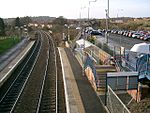Duloch

Duloch ( DOO-lokh), or Duloch Park, is a residential suburb of Dunfermline, in Fife, Scotland. The closest railway stations are Rosyth, Dunfermline Queen Margaret, Dunfermline City, Dalgety Bay and Inverkeithing. The lower price of large homes compared to homes across the Forth, as well as its proximity to the M90 motorway, has attracted many Edinburgh commuters. Local amenities include two large supermarkets (Tesco and Aldi) and a small shopping area. The nearby 'Fife Leisure Park' contains a cinema, gym, bowling alley, other leisure facilities and restaurants. Three primary schools serve the area - Masterton, Duloch and Carnegie Primaries. The campus of Duloch Primary school contains a large public library, café, gym, astro turf, several halls used for sports and community classes and Calaiswood, a special needs school. Duloch Park and Calais Muir Wood form the heart of the Duloch suburb, the latter being an ancient woodland owned by Fife Council and maintained by the Fife Coast and Countryside Trust. Duloch Park is mainly open grassland with a large pond to the north, a flooded former quarry. Its flat terrain is one reason for the large number of sustainable urban drainage system ponds in the area.
Excerpt from the Wikipedia article Duloch (License: CC BY-SA 3.0, Authors, Images).Duloch
Nightingale Place, Dunfermline Duloch
Geographical coordinates (GPS) Address Phone number Website Nearby Places Show on map
Geographical coordinates (GPS)
| Latitude | Longitude |
|---|---|
| N 56.0625 ° | E -3.4019 ° |
Address
Duloch Schools and Community Campus
Nightingale Place
KY11 8GN Dunfermline, Duloch
Scotland, United Kingdom
Open on Google Maps








